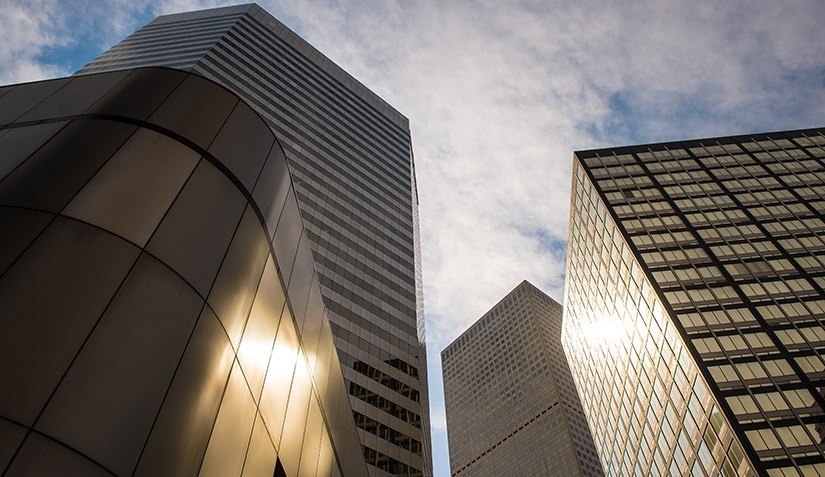According to research guided by the US Department of Energy’s National Renewable Energy Laboratory (NREL), using thermochromic windows in office buildings enhances energy efficiency across all climate zones in the United States by modifying the temperature inside, resulting in massive savings.
 Downtown Denver features many buildings with glass facades. Researchers from NREL say retrofitting these windows with thermochromic ones can improve energy efficiency across all climate zones in the United States. Image Credit: Dennis Schroeder, NREL.
Downtown Denver features many buildings with glass facades. Researchers from NREL say retrofitting these windows with thermochromic ones can improve energy efficiency across all climate zones in the United States. Image Credit: Dennis Schroeder, NREL.
The thermochromic windows, which use perovskite materials to capture solar energy, change from translucent to visibly absorbing or reflecting. The method reduces heating loads in hot climates and cooling loads in cold climates.
According to Lance Wheeler, the project’s Principal Investigator, upgrading to thermochromic windows saves a large amount of energy each year, with the major source of savings stemming from needing less heating energy for extensively glazed office buildings in cold or seasonal areas.
If each worker in the modeled office building drove an electric vehicle the length of a typical American commute, the annual energy could be utilized to completely charge every worker’s car every day of the year.
The research appears in the Advanced Energy Materials journal. Co-authors from NREL are Bryan Rosales, Janghyun Kim, Kevin Prince, Mirzo Mirzokarimov, Tom Daligault, Adam Duell, Colin Wolden, and Laura Schelhas. Other co-authors are from the Colorado School of Mines, the University of Wisconsin–Stout, and Swift Solar.
The study, which depended on PVwindow modeling software that Wheeler helped design, predicts that adding a thermochromic laminate to a single-pane or even double-pane window will result in significant savings.
Buildings consume over 40% of all primary energy in the United States, with heating being the major source. Beginning in the 1980s, coating technology changed window energy efficiency by strategically absorbing or reflecting infrared light while allowing visible light to travel through the glass. However, because slightly more than half of the sun’s energy occurs in visible wavelengths, buildings with substantial glass facades require more energy to heat or cool.
The researchers selected a 12-story structure with a window-to-wall ratio of 95% as their model. For a year, they recreated energy use in the building at 15-minute intervals in eight climate zones around the country, including Hawaii, Arizona, California, Colorado, New York, Wisconsin, Minnesota, and Alaska. They discovered that:
- Thermochromic double-pane windows outperformed building energy efficacy over double-pane windows in each zone
- Energy savings were higher in colder regions
- Thermochromic double-pane windows outpaced even triple-pane windows in the hottest climate zones.
The investigators determined that while triple-pane windows offered more energy savings than thermochromic double-pane windows in colder climates, introducing a thermochromic laminate to construct a triple-pane window offered the most annual energy savings when contrasted to the highest efficiency double-pane windows.
The thermochromic windows are activated by temperature, and the ideal transition temperature was calculated to be 20–27.5 °C (68–81.5 °F).
If the transition temperature is too high, then the window may not save energy, and buildings are better off with static windows. It is interesting that this range is valid across many different climates, from northern Minnesota to southern California. This is because dynamic windows reduce solar heat gain in the summers to save air conditioning, and they also increase solar heat gain when heat is needed in winters.
Lance Wheeler, Principal Investigator, National Renewable Energy Laboratory
The investigators merged modeling and experimentation to show a perovskite film sandwiched between two layers of glass. The thermochromic switching was tested for durability over 200 cycles.
We were able to significantly reduce the transition temperature in the lab to match the predicted ideal temperature. The work shows off the many areas of expertise at NREL and the power of collaboration between materials science and building energy science.
Lance Wheeler, Principal Investigator, National Renewable Energy Laboratory
The study was funded by the Department of Energy’s Building Technologies Office.
Journal Reference:
Rosales, B. A., et al. (2023) Thermochromic Halide Perovksite Windows with Ideal Transition Temperatures. Advanced Energy Materials. doi.org/10.1002/aenm.202203331.